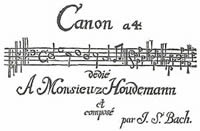 In electroacoustic terms, Steve Reich’s ‘Violin Phase’ is a pretty old piece, dating all the way back to 1967. Nonetheless, or perhaps even because of that, it brings some of the basic issues of electroacoustic music and electronic memory into plain view.
In electroacoustic terms, Steve Reich’s ‘Violin Phase’ is a pretty old piece, dating all the way back to 1967. Nonetheless, or perhaps even because of that, it brings some of the basic issues of electroacoustic music and electronic memory into plain view.
 There is some similarity between Steve Reich’s ‘Violin Phase’ and the Bach ‘Ciaccona’ in that they are in some basic sense repetitive and algorithmic. Their similarity can be shown in the possibility of reduction: “Violin Phase” can also be reduced to a one bar source, as in the image to the left. One might also note that Bach also created works which were entirely reducible to a single bar, even further than the Ciaccona (puzzle canons), as in the image to the right.
There is some similarity between Steve Reich’s ‘Violin Phase’ and the Bach ‘Ciaccona’ in that they are in some basic sense repetitive and algorithmic. Their similarity can be shown in the possibility of reduction: “Violin Phase” can also be reduced to a one bar source, as in the image to the left. One might also note that Bach also created works which were entirely reducible to a single bar, even further than the Ciaccona (puzzle canons), as in the image to the right.
But beyond that, they are utterly and completely different, even opposite to one another. Reich’s work is the product of the era of artificial memory: of recording, RPM’s and rounding error. It ends up strangely non-fictional or chemical, documenting imperfection and wandering with a sort of psychotropic effect. It is as much about things fitting together as it is about things not fitting together, using the strange transformations and positionings available to the consciousness in the age of recording and an urban sort of quasi-order. The quality of remembering belongs to the recordings and performer; the experience, very peculiar magic-carpet ride, belongs to the audience. Moreover, as a computational metaphor, Violin Phase also has a certain resonance. Computers are good at nothing if not doing the same thing over and over, and yet the results of these repetitions, in their exponentially expanding permutations, can be mined, re-twisted, and embellished upon in surprising and pleasing ways, even amidst the mnemonic and temporal slippage.
I wrote the karaoke-style program projected above this performance as a way to study the piece; later it began to seem attractive as a way of explaining ‘Violin Phase’ in simple terms, and in real time. So I styled it for presentation. Whether it helps or hurts the experience of the piece is up to the audience (which of course can shut its eyes), but I think that it is worth pointing out what a strange effect even the simplest electroacoustic ideas can have on conventional notation.